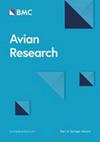Avian acoustic communication: Understanding of peripheral and central neural systems with ecological adaptations
IF 1.7
2区 生物学
Q1 ORNITHOLOGY
引用次数: 0
Abstract
Avian vocal communication represents one of the most intricate forms of animal language, playing a critical role in behavioral interactions. Both peripheral and central auditory-vocal pathways are essential for precisely integrating acoustic signals, ensuring effective communication. Like humans, songbirds exhibit vocal learning behaviors supported by complex neural mechanisms. However, unlike most mammals, songbirds possess the remarkable ability to regenerate damaged auditory cells. These capabilities offer unique opportunities to explore how birds adjust their vocal behavior and auditory processing in response to dynamic environmental conditions. Recent studies have advanced our understanding of the plasticity of avian vocal communication system, yet the vocal diversity and neurophysiological mechanisms underlying vocalization and hearing have often been examined independently. A comprehensive overview of how these systems interact and adapt in birds remains lacking. To address this gap, this review synthesizes the peripheral and central features of avian vocalization and hearing, while also exploring the mechanisms that drive the remarkable plasticity of these systems. Furthermore, it explores seasonal variations in bird vocalization and hearing and adaptations to environmental noise, focusing on how hormonal, neural, and ecological factors together shape vocal behavior and auditory sensitivity. Avian vocal communication systems present an exceptional model for studying the integration of peripheral and central vocal-auditory pathways and their adaptive responses to ever-changing environments. This review underscores the dynamic interactions between avian vocal communication systems and environmental stimuli, offering new insights into broader principles of sensory processing, and neuroplasticity.
鸟类声学通信:理解周围和中枢神经系统与生态适应
鸟类的声音交流是动物语言中最复杂的形式之一,在行为互动中起着至关重要的作用。外围和中枢听觉-声音通路都是精确整合声音信号,确保有效沟通所必需的。像人类一样,鸣禽表现出由复杂的神经机制支持的声乐学习行为。然而,与大多数哺乳动物不同,鸣禽具有再生受损听觉细胞的非凡能力。这些能力为探索鸟类如何根据动态环境条件调整其发声行为和听觉处理提供了独特的机会。近年来的研究促进了我们对鸟类发声交流系统可塑性的认识,但对发声和听力背后的声音多样性和神经生理机制的研究往往是独立的。关于这些系统如何在鸟类中相互作用和适应的全面概述仍然缺乏。为了解决这一差距,本文综合了鸟类发声和听觉的外围和中心特征,同时也探索了驱动这些系统显著可塑性的机制。此外,它还探讨了鸟类发声和听觉的季节性变化以及对环境噪声的适应,重点关注激素、神经和生态因素如何共同影响发声行为和听觉敏感性。鸟类的声音交流系统为研究外周和中枢声听觉通路的整合及其对不断变化的环境的适应性反应提供了一个特殊的模型。这篇综述强调了鸟类声音交流系统和环境刺激之间的动态相互作用,为感觉加工和神经可塑性的更广泛原理提供了新的见解。
本文章由计算机程序翻译,如有差异,请以英文原文为准。
求助全文
约1分钟内获得全文
求助全文
来源期刊

Avian Research
ORNITHOLOGY-
CiteScore
2.90
自引率
16.70%
发文量
456
审稿时长
46 days
期刊介绍:
Avian Research is an open access, peer-reviewed journal publishing high quality research and review articles on all aspects of ornithology from all over the world. It aims to report the latest and most significant progress in ornithology and to encourage exchange of ideas among international ornithologists. As an open access journal, Avian Research provides a unique opportunity to publish high quality contents that will be internationally accessible to any reader at no cost.
 求助内容:
求助内容: 应助结果提醒方式:
应助结果提醒方式:


